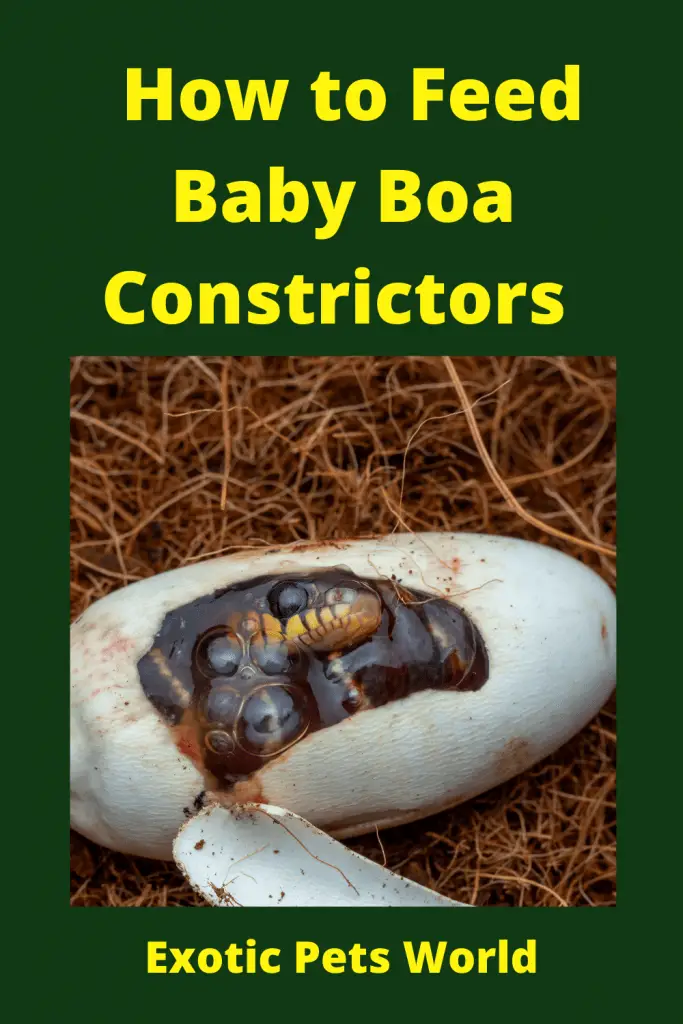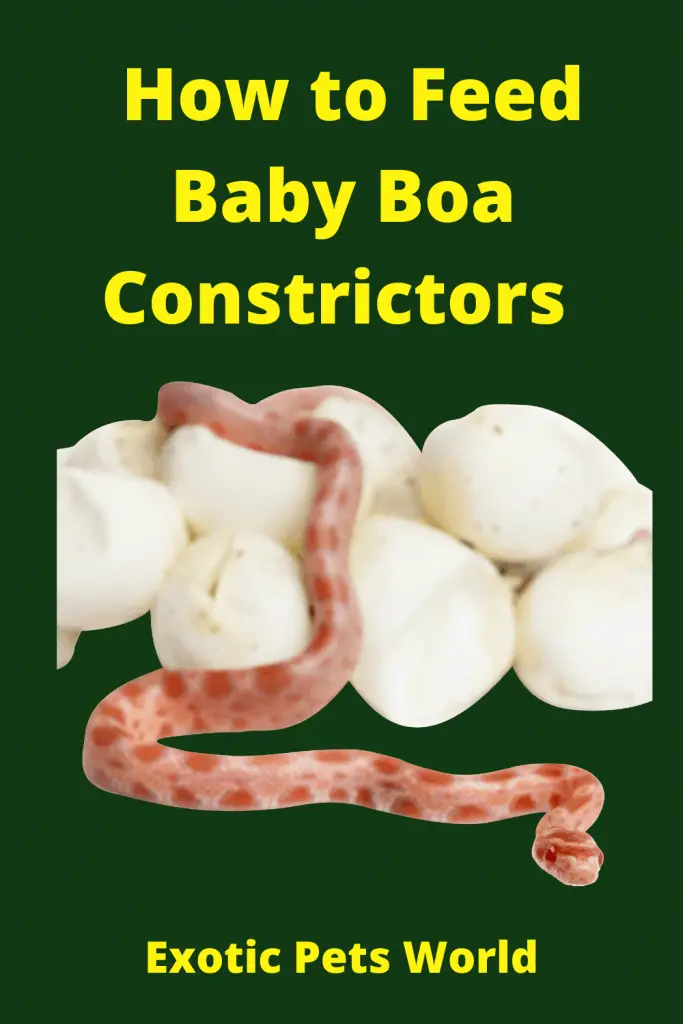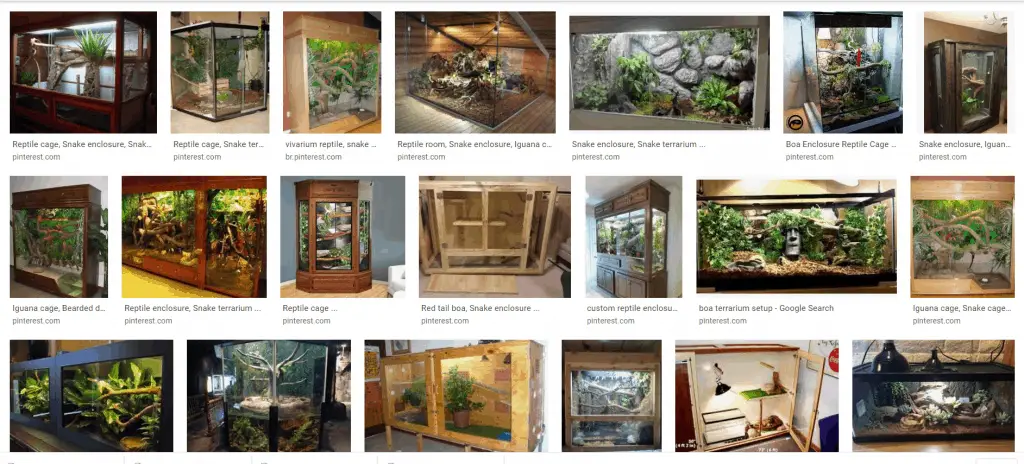How To Feed Baby Boa Constrictors
General Characteristic
COMMON NAME: Boa
SCIENTIFIC NAME: Boa constrictor
TYPE: Reptiles
DIET: Carnivore
GROUP NAME: Knot, Bed
AVERAGE Age/LIFE SPAN:22 to 28 years
Average SIZE:9-12 feet
Average Adult WEIGHT:55-60 pounds
BOA CONSTRICTOR COLOR PATTERN:
Boa constrictors wear some of the unique markings and stripes among all reptiles. Their bodies can be tan, green, yellow, or red and display beautiful cryptic patterns of jagged lines, diamonds, ovals, and circles. Their body color and design of the Boas depend upon the habitat they are living in.
Do you own a baby boa constrictor? Or you want to know how to feed and care for your boa constrictor? Read on to know all about Boa Constrictor.
The well being and health and fitness of any animal are dependent on profitable farming, and one of your most significant worries might be about feeding your baby boas.

How to Feed a Baby Boa Constrictor?
To feed baby boa, start with a thawed or fresh pinkie mouse and give this prey to your Boas once a week. Always use a pair of tongs while offering feed to them. Ensure the prey is the appropriate size for your pet to prevent choking or regurgitating, and never handle or play with a snake who has recently eaten food.
Boo constrictors are an excellent choice for snake keepers/owners because of their nature. Still, you may be overwhelmed and surprised if you are a newbie and you have to look for a baby boa because feeding a baby Boa is a general struggle for new owners.
One of the very first things to do is to make sure you choose optimum sized food according to Boas’ jaw proportion.
The rat/mice or any rodent should be about the same width as the thickest part of the boa constrictor’s middle body. Only feed the snake one food item at each feeding. Do not give multiple food items at the same time.
The best choice for baby boas is to give them pinkies (Baby mice who do not have any fur). Baby boas love to eat pinkies every time you give them. They are their best snack and are easy to digest. These pinkies are sold in the market in the frozen form mostly, so you will need to thaw them before feeding them to your Boas.
You thaw them by putting these pinkies in a zip-top bag and dipping it in warm water. It would be best if you did this to warm up the rodent to about 99° to 100° degrees Fahrenheit (37.5° – 38° C), equal to the live mouse’s temperature.
Use a pair of tongs or feeding tweezers, wiggle the pinkie in front of the boa constrictor to mimic the animal’s movements. Your boa will think it’s a live prey and never let you face the disappointment of not eating food.
Never use your hands to feed your baby boa constrictor directly. Not only can snakes bite and injure you, but they also associate with your hands if you provide them with hands. This will also put you at risk.
Baby boas have a faster metabolism than adult members of their species, and they must need to be fed more frequently.
Baby Boas Feeding Schedule:
Set a feeding schedule where you feed your baby boas once every five to seven days. Avoid overfeeding as it is harmful to boas overall health and can cause vomiting.
Precaution:
Do not handle the baby boas after feeding. In general, boas need about 45-48 hours to digest food properly, and handling it before 48 hours is harmful to the snakes.
If you handle it too soon after eating, your baby boa may vomit or regurgitate their food. It is painful for snakes and often causes other health problems and even death.
As your baby boa grows, increase the prey/pinkie’s size and feed once every ten to fourteen days.

Feeding an Adult Boa Constrictor
The process of feeding boa constrictor does not vary at any age, whether the animal is a baby, young, or an adult. You still have to make sure you provide them with the right size and quality food.
As they get older and more prominent, you will better understand why feeding with the hand is not recommended. Boas are healthy, muscular snakes, usually 9 to 10 feet long, and can weigh up to 62 pounds. So, according to their size, they will cause some severe damage if you try to feed them with your hands.
The type and size of the prey and the feedings’ frequency are the only changes in feeding a juvenile, baby, or adult boa. Where baby boas are usually provided with pinkies, some fully grown adults eat large rats or other large rodents such as rabbits, hamsters, and guinea pigs, but rats have the highest nutritional value.
As your snake gets older, the frequency of feeding begins to decrease. Feed every 10 to 14 days as they grow to 3 to 4 feet in length. When your boa constrictor is fully developed, feed only twice a month. Snakes must digest each food thoroughly, and it takes a long time between feedings.
In the wild:
A boa constrictor will eat multiple small animals such as lizards, bats, rats, birds, and squirrels in the wild or forests. Again, the size and type depend entirely upon the length of your boas.
Obesity is possible in boas, similar to humans, if you overfeed them or do not allow any activity. If the boa constrictor is obese, it can cause many health problems for them and ultimately shorten its lifespan.

Should You use Live Prey While Feeding Boa Constrictors?
A common question for snake owners is whether they should feed on dead/frozen prey or live prey.
Well, there is always a danger/threat if you feed your snake live prey because the prey you are providing to boas will fight for its life and will do everything to survive, including biting and scratching, which may harm you or your snake
Since your snake is more likely to get hurt, a dead, frozen rodent/prey is a great alternative. But the frozen food must be defrosted or thawed before feeding.
Behavior
Boas are beautiful and non-venomous constrictors found in tropical South and Central America. Like their cousins, i.e., anacondas, are tremendous swimmers, but they prefer to live on dry land. They live mainly in abandoned mammal burrows and hollow logs.
They have small, hooked teeth aligned in their jaws. They use their teeth to hold and grab prey, and they wrap their muscular body around them, squeeze them until they suffocate. Bose will also eat anything they can catch, including monkeys, birds, and wild boars. Their jaws can stretch wide to swallow whole large prey.
When are Boas Ready for Breeding?
They generally mate in the dry season. Usually, between April and August and Boas are polygynous, i.e., males intercourse with females multiple times.
Females lay eggs inside their bodies and give birth to up to 55-60 live babies. Boas are about 2 feet long when they are born and grow continuously throughout their life. Size
Well, What Size Do They Reach?
As we discussed above, their usual size ranges from 9 to 12 feet. In our experience, all subtypes of boa constrictors that are considered to have significant growth potential also reach almost 10 feet in length. The gigantic boa constrictor ever found is measured 18 feet in length.

Terrarium size/ Housing of Boas:
Terrarium size for boa constrictor is given below:
- Boa constrictor smaller than ( 7′) 1.5 m requires: 1.0 x 0.5 x 0.75 (length x depth x height)
- Boa constrictor over (7′) 1.5 m requires: 0.75 x 0.5 x 0.75 (length x depth x height)

How Often Does a Boa Shed?
There is usually no reasonable answer to this question, as several factors play a role in it.
Factors affecting Boas shedding rate:
- The most crucial factor is the snake’s growth rate, which depends mainly on food.
- The more food you give them, the smaller their cycle of the shed will become.
- The next factor is the temperature at which the boas are kept. The lower the weather is, the slower the animal’s metabolism, which affects the frequency of shedding.
- The age of the Boa constrictor also plays a role. The younger the snake, the shorter the gap between the shedding.
Because of the high growth potential of young snakes, hatchlings and neonates can shed up to 9 times a year if they are fed too much (which should not be done). In adult boas, about four to five sheds are expected each year.
What to Look for While Choosing a Boa Constrictor?
When you are ready to buy your pet boa constrictor, learn how to identify a healthy snake. Some of the symptoms include:
- Must be alert
- Strong and muscular body
- No loose skin
- Tongue flicking
- Clear eyes
- No sign of the previous shed (see the end of and tail eyes)
- No external parasites are visible
- Clean vent
- Healthy scales without brown or curved edges
- There should be no wounds on the outer skin
Where You can Buy Boas?
Healthy and extremely agile newborns (not stressed) can undoubtedly be found by professional snake breeders.
How Much do They cost?
Captive-bred boas are usually healthier and docile than those found in the jungle/wild. Prices can vary widely depending on the type and length of Boas. But many kinds of boas usually cost between $70 to $180.
Conclusion
Properly feeding your baby/adult boa will help build a foundation for a healthy adult. Always make sure you provide them the perfect prey and in a precise amount. Do not overfeed them or do not give them big prey; otherwise, vomiting or choking may happen. Make sure you provide a proper food schedule to keep your snake happy and healthy.


Your article helped me a lot, is there any more related content? Thanks!